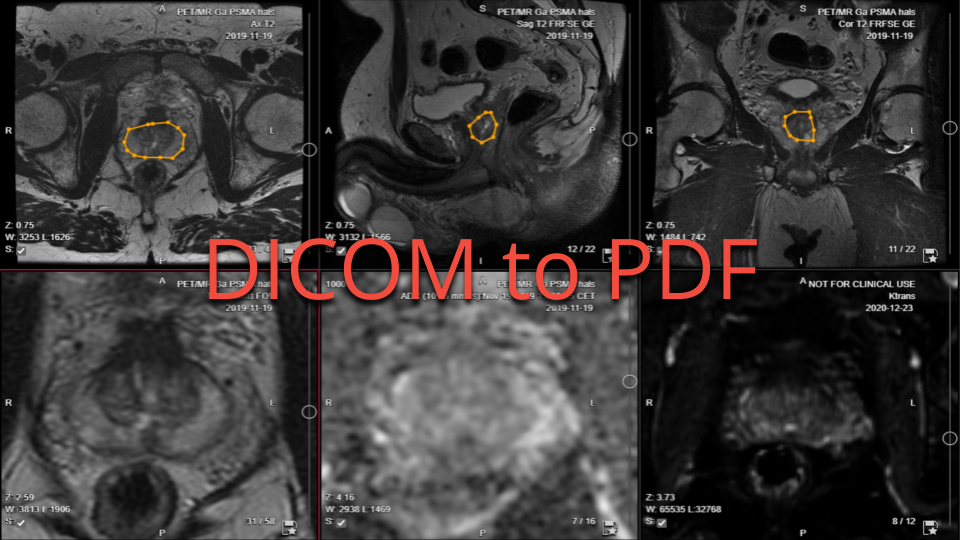Converting DICOM to PDF: A Comprehensive Guide to Methods and Libraries

In the world of medical imaging, DICOM (Digital Imaging and Communications in Medicine) is the standard format for storing and transmitting medical images. However, there are many situations where converting these DICOM files to more universally accessible formats like PDF becomes necessary. This article will explore various methods and libraries available for converting DICOM to PDF, highlighting their strengths and key features.
Popular Libraries and Methods
1. Apryse SDK (formerly PDFTron)
Apryse SDK offers a robust solution for converting DICOM to PDF through its Advanced Imaging Module.
Key Features:
- Supports DICOM and other advanced imaging formats (HEIC, ARW, DCR, RAF)
- High-quality conversion
- Customizable conversion options
Usage:
PDFNet.Initialize();
PDFNet.AddResourceSearchPath("path/to/Lib/");
using (PDFDoc doc = new PDFDoc())
{
AdvancedImagingConvertOptions opts = new AdvancedImagingConvertOptions();
opts.SetDefaultDPI(72.0);
pdftron.PDF.Convert.FromDICOM(doc, inputFilePath, opts);
doc.Save(outputFilePath, SDFDoc.SaveOptions.e_remove_unused);
}
2. Aspose.PDF for Python
Aspose.PDF provides a Python library for converting DICOM to PDF, offering a straightforward approach for developers.
Key Features:
- Easy installation via pip
- Supports various PDF standards and specifications
- Extensive conversion capabilities (PDF to Word, Excel, PowerPoint, etc.)
Usage:
def convert_DICOM_to_PDF(infile, outfile):
document = Document()
page = document.Pages.Add()
image = Image()
image.FileType = ImageFileType.Dicom
image.File = infile
# Set page dimensions and add image
page.Paragraphs.Add(image)
document.Save(outfile)
3. PostDICOM
PostDICOM offers a cloud-based solution for converting DICOM to PDF, catering to medical professionals and institutions.
Key Features:
- User-friendly interface
- Real-time progress monitoring
- Integrated with medical workflows
- Versatile output options
Process:
- Initiate conversion by clicking "Print to HTML"
- Select series and layout
- Monitor progress in the server job list
- View the generated content
- Save as PDF or print directly
Also Read: The Ultimate Guide to DICOM Conversion Tools: Everything You Need to Know in 2024
Comparing the Options
When considering these different methods and libraries, it's important to weigh their pros and cons:
Apryse SDK offers high-quality conversion and supports multiple formats, making it a versatile choice. However, it requires integration into an existing codebase, which may be challenging for some users.
Aspose.PDF is easy to use with Python and offers extensive features, making it attractive for Python developers. However, it may require additional setup for a .NET environment, which could be a drawback for some users.
PostDICOM provides a user-friendly, cloud-based solution that's accessible to non-technical users. However, it's dependent on an internet connection and may raise potential privacy concerns for sensitive medical data.
Choosing the Right Method
When selecting a method for converting DICOM to PDF, consider the following factors:
- Technical expertise required
- Integration with existing systems
- Volume of conversions needed
- Privacy and security requirements
- Budget constraints
Summary
Converting DICOM to PDF is a crucial task in many medical and research settings. Whether you choose a programming library like Apryse SDK or Aspose.PDF, or a cloud-based solution like PostDICOM, each option offers unique strengths to suit different needs. By understanding these methods and their features, you can select the most appropriate tool for your specific requirements.
Also Read: How to Convert DICOM to PPT: A Comprehensive Guide for Medical Professionals
FAQ
-
Q: Why would I need to convert DICOM to PDF? A: Converting DICOM to PDF can make medical images more accessible to patients, facilitate sharing with non-medical professionals, and enable easier integration with electronic health records.
-
Q: Are these conversion methods HIPAA compliant? A: While the methods themselves can be used in HIPAA-compliant workflows, ensuring overall HIPAA compliance depends on how you implement and secure the entire process.
-
Q: Can these methods handle large volumes of DICOM files? A: Yes, most of these methods can be automated for batch processing. However, performance may vary based on the specific implementation and hardware resources.
-
Q: Do these conversions maintain the quality of the original DICOM image? A: Generally, yes. However, some loss of information is possible, especially regarding metadata. It's important to test the output quality for your specific use case.
-
Q: Can I customize the PDF output (e.g., add annotations, adjust layout)? A: Yes, most libraries offer customization options. Apryse SDK and Aspose.PDF, in particular, provide extensive customization capabilities.
By leveraging these tools and methods, healthcare professionals and developers can streamline their workflows and improve accessibility to critical medical imaging data. As the field of medical imaging continues to evolve, so too will the technologies that support it.
At Collective Minds Radiology, we understand the importance of efficient and secure handling of medical imaging data. Our cloud-based solutions are designed to seamlessly integrate with various imaging formats, including DICOM, ensuring that healthcare professionals have access to the tools they need for optimal patient care. Whether you're looking to convert DICOM to PDF or explore other advanced imaging capabilities, our platform is here to support your radiology needs with cutting-edge technology and global collaboration opportunities.
Pär Kragsterman, CTO and Co-Founder of Collective Minds Radiology
Reviewed by: Mathias Engström on October 30, 2024




